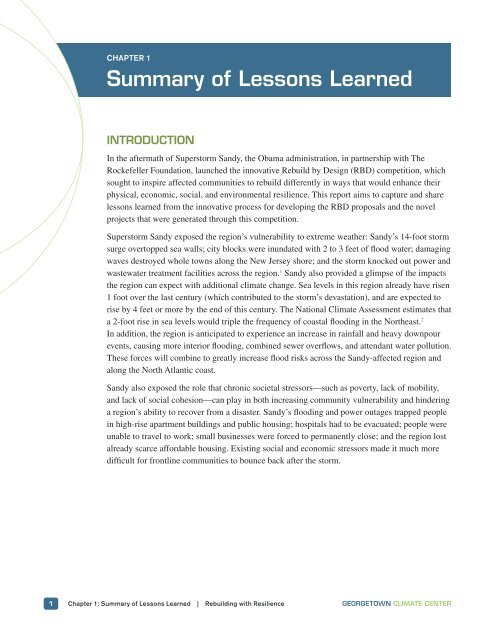Rebuilding with Resilience
dw0r306aHfX
dw0r306aHfX
Create successful ePaper yourself
Turn your PDF publications into a flip-book with our unique Google optimized e-Paper software.
CHAPTER 1<br />
Summary of Lessons Learned<br />
INTRODUCTION<br />
In the aftermath of Superstorm Sandy, the Obama administration, in partnership <strong>with</strong> The<br />
Rockefeller Foundation, launched the innovative Rebuild by Design (RBD) competition, which<br />
sought to inspire affected communities to rebuild differently in ways that would enhance their<br />
physical, economic, social, and environmental resilience. This report aims to capture and share<br />
lessons learned from the innovative process for developing the RBD proposals and the novel<br />
projects that were generated through this competition.<br />
Superstorm Sandy exposed the region’s vulnerability to extreme weather: Sandy’s 14-foot storm<br />
surge overtopped sea walls; city blocks were inundated <strong>with</strong> 2 to 3 feet of flood water; damaging<br />
waves destroyed whole towns along the New Jersey shore; and the storm knocked out power and<br />
wastewater treatment facilities across the region. 1 Sandy also provided a glimpse of the impacts<br />
the region can expect <strong>with</strong> additional climate change. Sea levels in this region already have risen<br />
1 foot over the last century (which contributed to the storm’s devastation), and are expected to<br />
rise by 4 feet or more by the end of this century. The National Climate Assessment estimates that<br />
a 2-foot rise in sea levels would triple the frequency of coastal flooding in the Northeast. 2<br />
In addition, the region is anticipated to experience an increase in rainfall and heavy downpour<br />
events, causing more interior flooding, combined sewer overflows, and attendant water pollution.<br />
These forces will combine to greatly increase flood risks across the Sandy-affected region and<br />
along the North Atlantic coast.<br />
Sandy also exposed the role that chronic societal stressors—such as poverty, lack of mobility,<br />
and lack of social cohesion—can play in both increasing community vulnerability and hindering<br />
a region’s ability to recover from a disaster. Sandy’s flooding and power outages trapped people<br />
in high-rise apartment buildings and public housing; hospitals had to be evacuated; people were<br />
unable to travel to work; small businesses were forced to permanently close; and the region lost<br />
already scarce affordable housing. Existing social and economic stressors made it much more<br />
difficult for frontline communities to bounce back after the storm.<br />
1 Chapter 1: Summary of Lessons Learned | <strong>Rebuilding</strong> <strong>with</strong> <strong>Resilience</strong> GEORGETOWN CLIMATE CENTER


